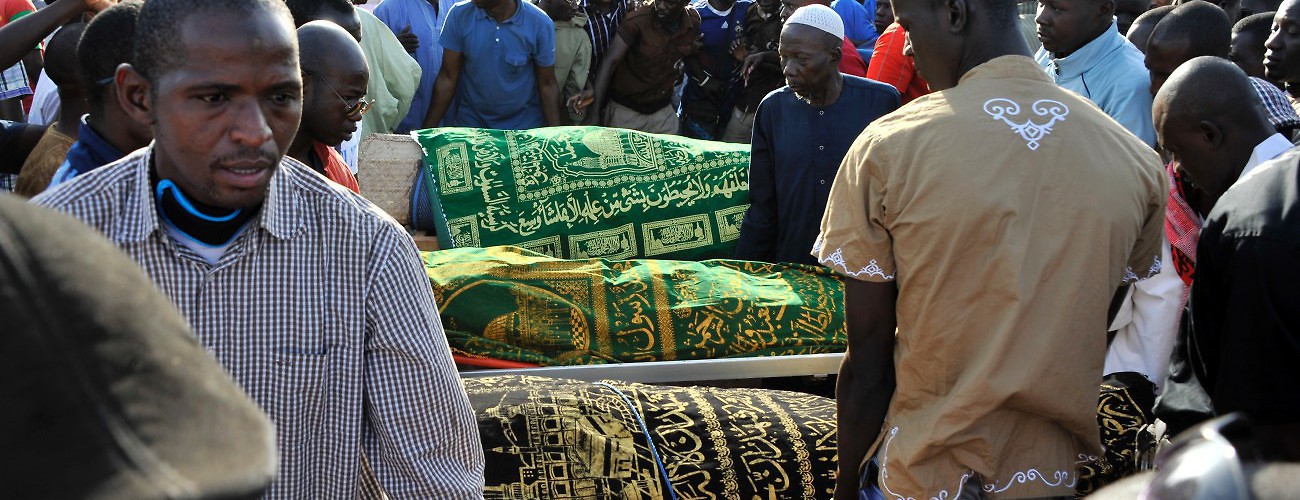The bodies of five of the victims of the November 2015 attack during their funeral in Bamako. Gunmen had gone on a shooting rampage at the luxury Radisson hotel in Mali's capital, seizing 170 guests and staff. Bamako, Mali, November 25, 2015. (AFP/Getty Images)
In the past six months, Al-Qaeda in the Islamic Maghreb (AQIM) have executed two deadly, well-coordinated attacks in Mali and Burkina Faso’s respective capitals of Bamako and Ouagadougou. The attacks, which AQIM coordinated alongside its al-Mourabitoun affiliate, garnered al-Qaeda’s North Africa affiliate international media coverage at a time when these stories had mostly belonged to the Islamic State (IS). AQIM seemed to be reminding the world that it has its own raison d’etre of creating its own Islamic caliphate spanning the Maghreb and Sahel regions of north western Africa. Indeed, the group seems to be mending or strengthening ties with its various offshoots to achieve this. Most importantly, it left many wondering where and how AQIM could strike next.
While AQIM attacks in Bamako and Ouagadougou caught many by surprise, they were not that unexpected. In Mali, AQIM had been particularly active since 2012, when a military coup and associated security vacuum afforded al-Qaeda’s North African proxy a foothold in the country. Although violence focused on militant strongholds in Mali’s desert north—discriminately targeting United Nations peacekeepers and interests in the region—a series of shootings in Bamako in early 2015 demonstrated that armed actors had the intent and operational capacity to target the Malian capital.
Likewise, in Burkina Faso, the threat of militancy was also rising. Prior to the assault on Ouagadougou’s Splendid Hotel and adjacent Cappuccino Café, Islamist militants had executed several attacks targeting both security and civilian interests in the country’s Oursi Department bordering Burkina Faso. This included the August 2015 kidnapping of a Romanian national at a manganese mine near the settlement of Tambao.
Increased security in Bamako and Ouagadougou may lessen these cities’ susceptibility to further militant attacks of the scale and deadliness recently witnessed. Nonetheless, both urban centers will remain high-value targets due to their symbolism as the political and commercial epicenters of Western-aligned regimes hostile to the presence of AQIM and its counterparts. However, the rural hinterlands of Mali’s desert north and its shared border with Burkina Faso will continue to be vulnerable to militant violence taking the form of armed ambushes, kidnappings, and both crude and sophisticated bomb attacks. These acts of violence will likely be spearheaded by AQIM’s al-Mourabitoun and recently-established Macina Liberation Front (MLF) affiliates which have both demonstrated a widening operational reach.
Formed in 2015, the MLF is AQIM’s newest alleged offshoot. The group is suspected to be a front for the Malian-based Ansar Dine Islamist movement, itself believed to be AQIM’s proxy in the West African nation. Armed with the burning ambition of resurrecting the Fulani-led Macina empire, the MLF’s objectives has seen the group perpetrating acts of violence in central and southern Mali where the antiquated Islamic kingdom once existed. Given the ethnic component of the MLF, there are concerns that the group could infiltrate neighboring countries such as Burkina Faso, Cote d’Ivoire and Guinea where it is believed to have strong ethnic and familial ties. Within these areas, the MLF could establish rear bases outside the scope of counterterrorism initiatives and raise capital through banditry, smuggling, and kidnapping. In terms of kidnapping, expatriate-laden gold mining facilities in Mali’s shared borders with Burkina Faso, Senegal, Cote d’Ivoire and Guinea, could be a particularly attractive target for the MLF.
In terms of al-Mourabitoun, the group currently serves as AQIM’s most powerful and far-reaching affiliate. Amid a number of joint operations coordinated alongside AQIM, al-Mourabitoun seems to have re-aligned itself with al-Qaeda following an earlier spat between the group’s famed leader, Mokthar Belmokthar, and the AQIM leadership. Nonetheless, al-Mourabitoun’s reintegration into AQIM gives al-Qaeda’s North African wing a reach which, in addition to Mali and Burkina Faso, extends to countries such as Algeria, Libya, Niger, and Mauritania. These countries will continue to remain threatened by al-Mourabitoun operations which have often assumed a distinctly anti-Western, particularly anti-French, undertone. Consequently, attacks against hotels, mining sites and the kidnapping of foreigners will remain a concern in these countries.
Al-Mourabitoun and AQIM may also attempt to extend their operational presence into new frontiers. From a strategic perspective, Senegal may be under particular threat. The country’s involvement in regional counterterrorism initiatives, highlighted by its membership in the Trans-Saharan Counterterrorism initiative and its 2016 hosting of the US Flintlock military exercises, makes the country a prime candidate for retaliatory attacks by Islamist militant groups. A spate of terror-related arrests in Senegal, including the recent detention of 500 persons in a counterterrorism crackdown, suggests that operational networks may already be present in the country. While Senegal’s bustling metropolis of Dakar could serve as a prime target, settlements located along the country’s long and porous borders with Mali and Mauritania are assessed as most vulnerable to armed violence.
Corruption, weak political institutions, and oppressive governance will continue to inhibit many African countries from nullifying the threat posed by AQIM and its affiliates. While these deficiencies may be counterbalanced by Western patronage, foreign intervention always runs the risk of aiding extremist groups in their recruitment among communities disenchanted with the faux democracy exported and endorsed across the continent. Consequently, violence by AQIM and its counterparts is set to remain a feature of the security landscape in North and West Africa for the foreseeable future.





